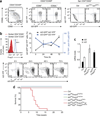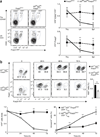Id2 and Id3 maintain the regulatory T cell pool to suppress inflammatory disease
- PMID: 24973820
- PMCID: PMC4365819
- DOI: 10.1038/ni.2928
Id2 and Id3 maintain the regulatory T cell pool to suppress inflammatory disease
Abstract
Regulatory T (Treg) cells suppress the development of inflammatory disease, but our knowledge of transcriptional regulators that control this function remains incomplete. Here we show that expression of Id2 and Id3 in Treg cells was required to suppress development of fatal inflammatory disease. We found that T cell antigen receptor (TCR)-driven signaling initially decreased the abundance of Id3, which led to the activation of a follicular regulatory T (TFR) cell-specific transcription signature. However, sustained lower abundance of Id2 and Id3 interfered with proper development of TFR cells. Depletion of Id2 and Id3 expression in Treg cells resulted in compromised maintenance and localization of the Treg cell population. Thus, Id2 and Id3 enforce TFR cell checkpoints and control the maintenance and homing of Treg cells.
Figures








References
Publication types
MeSH terms
Substances
Associated data
- Actions
Grants and funding
- AI70535/AI/NIAID NIH HHS/United States
- R37 AI038425/AI/NIAID NIH HHS/United States
- U19 AI070535/AI/NIAID NIH HHS/United States
- R01 AI108651/AI/NIAID NIH HHS/United States
- CA054198/CA/NCI NIH HHS/United States
- 1P01AI102853/AI/NIAID NIH HHS/United States
- R37 CA054198/CA/NCI NIH HHS/United States
- R01 AI038425/AI/NIAID NIH HHS/United States
- P01 AI102853/AI/NIAID NIH HHS/United States
- AI 38425/AI/NIAID NIH HHS/United States
- R01 CA054198/CA/NCI NIH HHS/United States
- R01 CA078384/CA/NCI NIH HHS/United States
- AI 7211/AI/NIAID NIH HHS/United States
- CA78384/CA/NCI NIH HHS/United States
LinkOut - more resources
Full Text Sources
Other Literature Sources
Molecular Biology Databases

